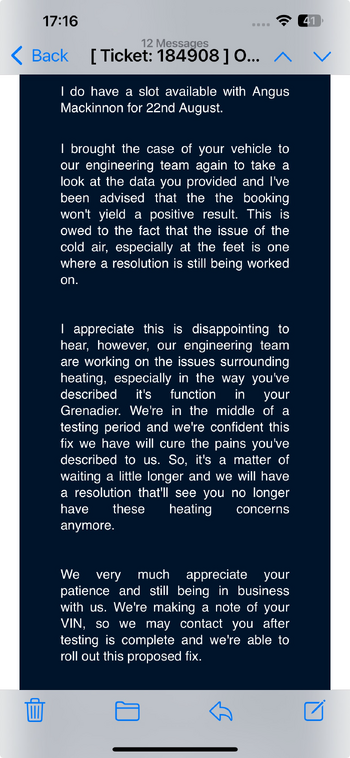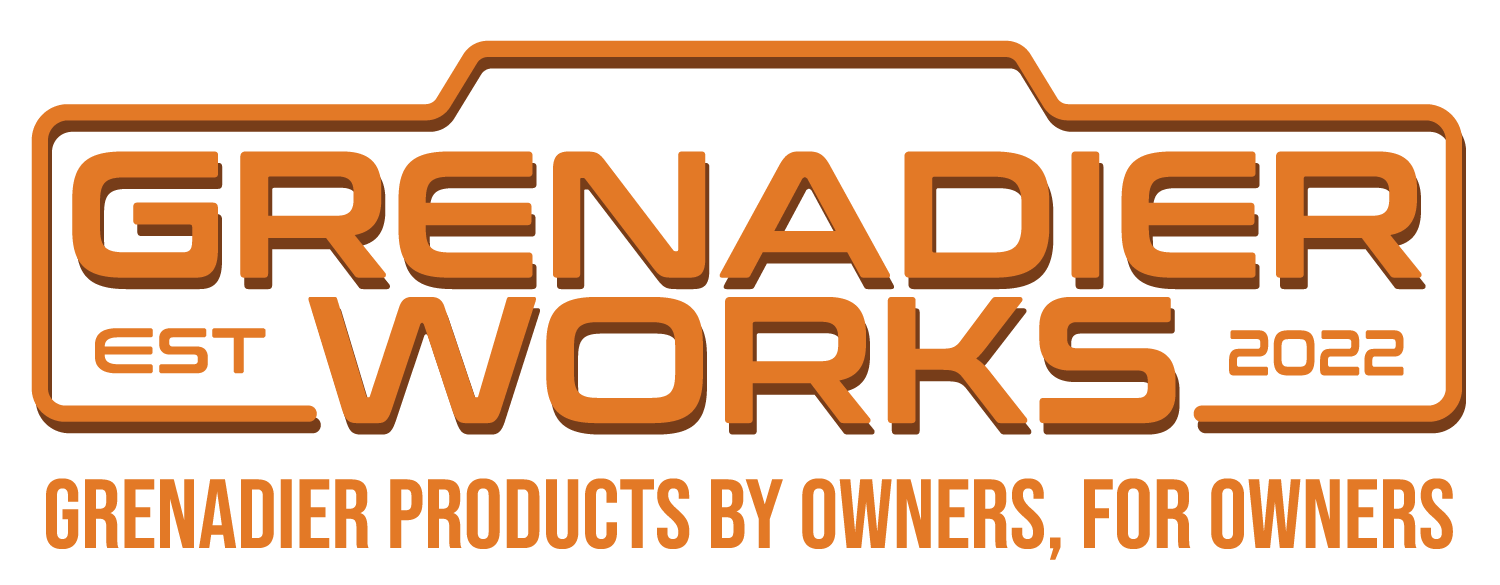Smart alternators are controlled by an ECU to limit charging to a range as a part of emissions optimization
The Grenadier Forum
Register a free account today to become a member! Once signed in, you'll be able to contribute to the community by adding your own topics, posts, and connect with other members through your own private inbox! INEOS Agents, Dealers or Commercial vendors please use the contact us link at the bottom of the page.
-
Guest submit your best shot for a chance to win the December Photo Contest. Photo Contest Click Here
You are using an out of date browser. It may not display this or other websites correctly.
You should upgrade or use an alternative browser.
You should upgrade or use an alternative browser.
Heating system is useless
- Thread starter River Meese
- Start date
not HVAC but HAVOC system is what they deliveredSeriously they should be embarrassed enough to fix this for all existing owners. What they have produced is an hvac system from a high school automotive class project. It’s pure ass
If it is a lead-acid battery, doesn't matter if it is wet or AGM, small currents are killing them as well. That is due to the growth of crystals while power is taken out. High currents lead to small, fine crystals, low current (like ECU, smartphone loading, etc.) lead to large crystals.I’m glad you’ve got your new order in.
I don’t think there is anything wrong with the batteries as supplied. I think the issue is when they are allowed to go flat especially if that happens a few times. Most batteries apart from Lithium will quickly be destroyed if completely flattened. Maybe your Grenadier was parked up along time before delivery or since and not had the batteries maintained?
These crystals are material which can not be used for power and they block the flow of current. When you charge the battery. the small and fine crystals are reverted very well. It is difficult to revert the large crystals. They may never go away and thereby you loose electrical active material, reducing the battery capacity and power thereby.
Another effect is, that when taking power from a battery both plate materials (lead and lead oxide) is turned into lead sulfate (which is reverted to lead and lead oxide while charging). That leads to physical stress in the plates and small parts can break apart, also reducing power and capacity. That an donly that is addressed by AGM. It keeps these parts in place, so they do not fall down and are lost for the capacity.
AWo
Thanks. Although I’ve read all about this stuff most of it goes straight over my head to be fair. That’s why I’m not a mechanic or technician.If it is a lead-acid battery, doesn't matter if it is wet or AGM, small currents are killing them as well. That is due to the growth of crystals while power is taken out. High currents lead to small, fine crystals, low current (like ECU, smartphone loading, etc.) lead to large crystals.
These crystals are material which can not be used for power and they block the flow of current. When you charge the battery. the small and fine crystals are reverted very well. It is difficult to revert the large crystals. They may never go away and thereby you loose electrical active material, reducing the battery capacity and power thereby.
Another effect is, that when taking power from a battery both plate materials (lead and lead oxide) is turned into lead sulfate (which is reverted to lead and lead oxide while charging). That leads to physical stress in the plates and small parts can break apart, also reducing power and capacity. That an donly that is addressed by AGM. It keeps these parts in place, so they do not fall down and are lost for the capacity.
AWo
Moll marketing blurb seems to think their AFB batteries are AGM in disguise
AGM versus AGM No Longer Necessary
MOLL-Batterien - der Auto-Batterien-Spezialist. PKW-Batterien, LKW-Batterien, Motorrad-Batterien. Premium-Qualität Made in Germany.
EFB means there is a labyrinth inside the battery lid to prevent water from evaporating. Because evaporated water needs to run a long way to leave the battery through the ventilation, it has time to condensate and flow back again instead leaving the battery. That keeps it working for an extended period of time.
That has nothing to do with AGM. AGM means that the acid is bound into glass fibre mats between the lead and lead oxide plates stabilizing them and thereby making them somewhat more resilient to low currents. But low current is not what lead-acid batteries (wet, AGM or gel) are intended for.
AWo
That has nothing to do with AGM. AGM means that the acid is bound into glass fibre mats between the lead and lead oxide plates stabilizing them and thereby making them somewhat more resilient to low currents. But low current is not what lead-acid batteries (wet, AGM or gel) are intended for.
AWo
Thanks. Way over my head.
Most stuff on here is for me, I just use it to tell the dealer what needs doing or ideas for adding to the vehicle. All very helpful but I'm no mechanic.Thanks. Way over my head.
Lynn told us they removed the aux battery for several reasons, including that the supplier is no longer making a part (ctek 120 I believe). If IA were to replace that part with another, the truck would need recertification/homologation which would be stupidly expensive for a system that that the aftermarket has provided better options.
I have 1 unused in box if anyone is interested?(CTEK 120)Lynn told us they removed the aux battery for several reasons, including that the supplier is no longer making a part (ctek 120 I believe). If IA were to replace that part with another, the truck would need recertification/homologation which would be stupidly expensive for a system that that the aftermarket has provided better options.
No, you needed the CTEK 250 SE for a solar MPPT.Did the Ctec 120 have solar input?
So the average owner is much better off without the factory option and putting in a much more versatile optionNo, you needed the CTEK 250 SE for a solar MPPT.
YesSo the average owner is much better off without the factory option and putting in a much more versatile option
I would say the average user does not need a second battery. What IA did was reduce/remove the need for people to carry a jump start pack.So the average owner is much better off without the factory option and putting in a much more versatile option
Almost everyone who wants a second ( or third! ) battery - to use as an independent power source from the main starter battery... Didn't get anything they wanted and must go after market.
So, strongly agree that the after market provided the solution. IA solved a problem that only a few people may have had.
Mine has at least 60c in the back and virtually nothing in the frontJust an update on this...
The car has come back from its service and recalls. The problem with the heating was the pressure tank that other people have mentioned. The mechanic noticed the pressure tank had been leaking. He has repressurised the tank and the heater is working again but he has ordered a new pressure tank from Belgium which will take about 4 weeks to arrive in NZ. Now the temporary fix is in place, the heater works well, after about a 5 minute warm up period.
It's great to be back driving the Grenadier without misgivings. The misbehaving heater had been the only thing that was truly irritating me.
Was that the same
Did they fix it
Bleed the system many times. Make sure both expansion tanks are topped up to max.Mine has at least 60c in the back and virtually nothing in the front
Was that the same
Did they fix it
Try turning aircon off. Try shutting rear vents. It's certainly not perfect but will help
Just came across your post . I have also been told it’s a major design fault and nothing can be done . Mine has never worked since i got it and now it’s on 11,000m . I have resorted to buying a plug in one from amazon and that gives me hot air in cold weather . I can’t even sell mine as no one will touch these grenadiers , no dealer will put it on the floor and resale values have plummeted . They have mine back in the service centre trying to fix it again .The heating system in my field master has been rubbish from day 1
Now covered 7000 miles.
Car was delivered with a damaged water hose which was replaced by the selling dealer.
However they could not get the heater to blow anything other than cold air into the footwells.
Eventually went to another (service) dealer who did improve matters by bleeding the system
However the whole system is rubbish for a £70k vehicle
Ineos have admitted that the heating system is poor and suggest running in auto mode once you’ve got the car warm.
Even then my feet are always cold
They have accepted that it’s rubbish and a very basic design.
There are no plans to improve or modify it.
I believe it is not of merchantable quality and certainly not fit for purpose !!!
Really spoils an otherwise super 4x4
- Local time
- 11:13 PM
- Joined
- Dec 28, 2021
- Messages
- 1,122
Others work, so what is different about yours? Who is your dealer and what have they done?Just came across your post . I have also been told it’s a major design fault and nothing can be done . Mine has never worked since i got it and now it’s on 11,000m . I have resorted to buying a plug in one from amazon and that gives me hot air in cold weather . I can’t even sell mine as no one will touch these grenadiers , no dealer will put it on the floor and resale values have plummeted . They have mine back in the service centre trying to fix it again .
The heating system in my field master has been rubbish from day 1
Now covered 7000 miles.
Car was delivered with a damaged water hose which was replaced by the selling dealer.
However they could not get the heater to blow anything other than cold air into the footwells.
Eventually went to another (service) dealer who did improve matters by bleeding the system
However the whole system is rubbish for a £70k vehicle
Ineos have admitted that the heating system is poor and suggest running in auto mode once you’ve got the car warm.
Even then my feet are always cold
They have accepted that it’s rubbish and a very basic design.
There are no plans to improve or modify it.
I believe it is not of merchantable quality and certainly not fit for purpose !!!
Really spoils an otherwise super 4x4
Similar threads
- Replies
- 33
- Views
- 2K
- Replies
- 19
- Views
- 1K
- Replies
- 6
- Views
- 550
- Replies
- 44
- Views
- 3K
3rd party Videos
Fake news and the complexity of reviews and bad comparisions
- Replies
- 34
- Views
- 6K




